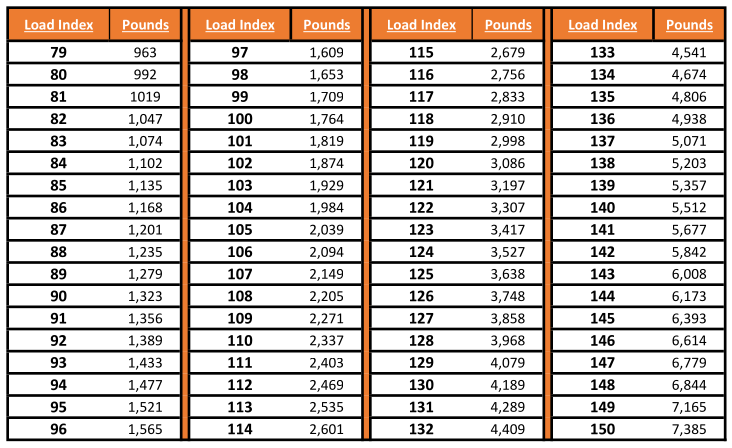Tire Buying Guides
Tire load rating guide

Tire Buying Guides

There are plenty of attributes to consider when purchasing your next set of tires. Some of the biggest include performance type and mileage warranty.
But load rating, while often overlooked, is one of the most important attributes, and that’s especially true for drivers who frequently tow and haul goods and materials.
You might be asking yourself “what is tire load rating,” and you’re not alone. While tires are strong, they do have a maximum amount of weight that they can carry, and excessive loads can damage your tires and shorten their lifestyle.
Understanding how to interpret this rating is important when shopping for new tires and for keeping yourself safe on the road.
In addition, having a better understanding of the tire load rating chart will help you decide which tire can handle the weight you might be placing on it. Here, we’ll explain what a tire load rating chart is.
The tire load rating refers to the amount of weight each tire can safely carry when properly inflated. Because the weight of the vehicle is distributed among all four wheels, each tire has a significant amount of weight to support.
Automotive and tire manufacturers take into consideration the overall weight of the vehicle when loaded with both passengers and cargo. With these factors in mind, the tire should ideally be able to support the vehicle's weight when fully loaded.

Because you don’t want a tire with a rating unfit for the weight of your vehicle and the things inside of it. At best you’ll have premature wear on your tires, but the worst outcome could be a complete failure of the tire – and we don’t even want to think about what might happen then.
Remember, your car's tires serve many roles. Not only are they meant to provide superior traction, but they're also intended to shoulder the full weight of the vehicle.
When you count the vehicle’s weight, the occupants inside, and the cargo loaded in the vehicle, it all begins to add up. Tire manufacturers consider this, and so should you, as it serves as an essential guideline when purchasing new tires.
Tire manufacturers consider the load rating when developing their tires. Still, even after the tire is made, extensive real-world testing of their tires is done to ensure they can meet or exceed their designated load capacity.
After these tests are completed, the manufacturers assign a two- or three-digit load index number to denote the maximum load rating.
Maximum load ratings denoted in pounds or kilograms are also included on the sidewall of the tires. Current load indexes used for cars and light-duty trucks range from "70" to "110", or 761 to 2337 pounds, respectively.
The higher the load index number, the greater the tire's load-carrying capacity:

Yes, tire load ratings do affect your ride’s performance, especially if you haul or tow materials, goods, boats, trailers, and so on. While tires are strong, the weight of your vehicle and whatever you’re towing puts extra pressure on them, which can cause premature wear or a blowout. It's very important to check your tire's air pressure regularly as the car tire load rating is only accurate when the tire is properly inflated.
Likewise, be sure to check your tires for signs of premature wear before your next haul or tow to avoid preventable issues while you’re on the road.
Besides premature wear or possibly a blowout situation, a tire that falls inside the proper window of the load rating chart will safely handle the loads you place on it (assuming it’s inflated correctly), which will make for a better ride and efficient fuel mileage – or at least as efficient as possible depending on the load being carried.
In most cases, the load index number is included near the end of an alphanumeric format on the tire's sidewall. This format also contains the tire's width, sidewall height, size in diameter, and maximum speed rating:
The maximum load rating is located on the inner circumference of the sidewall. Both may be hard to find on some tires, so you may want to use a flashlight and a keen eye to find the index number.
Automotive manufacturers usually include the recommended tire size and load index rating on a metal placard on the driver's side door jamb, or on a sticker located on the rear left passenger side door jamb.
Information is also included on the amount of weight distributed to each wheel, which is useful for purchasing a tire with ample load capacity.

Yes, you should consider the load index when tire shopping. Like we mentioned before, a tire that falls within the proper window on the tire load index chart for the conditions you drive in will be overall safer in the long run. This is especially important if you tow or haul frequently and/or with heavy items.
For the average driver who doesn’t tow or haul much, there’s less to worry about; tire manufacturers and carmakers have a fairly broad margin of operation for the load index.
Still, it’s easy enough to look at a tire and cross-reference the load index stamped on it to the tire load index chart here at Simple Tire to ensure it is safe for the conditions you’ll drive under.
Nonetheless, if you’re ever unsure about the tire load index – or any other aspect of tires – feel free to give one of our representatives a call. We’ll be happy to guide you through the tire shopping process to ensure you get the right rubber for your ride.
Search By